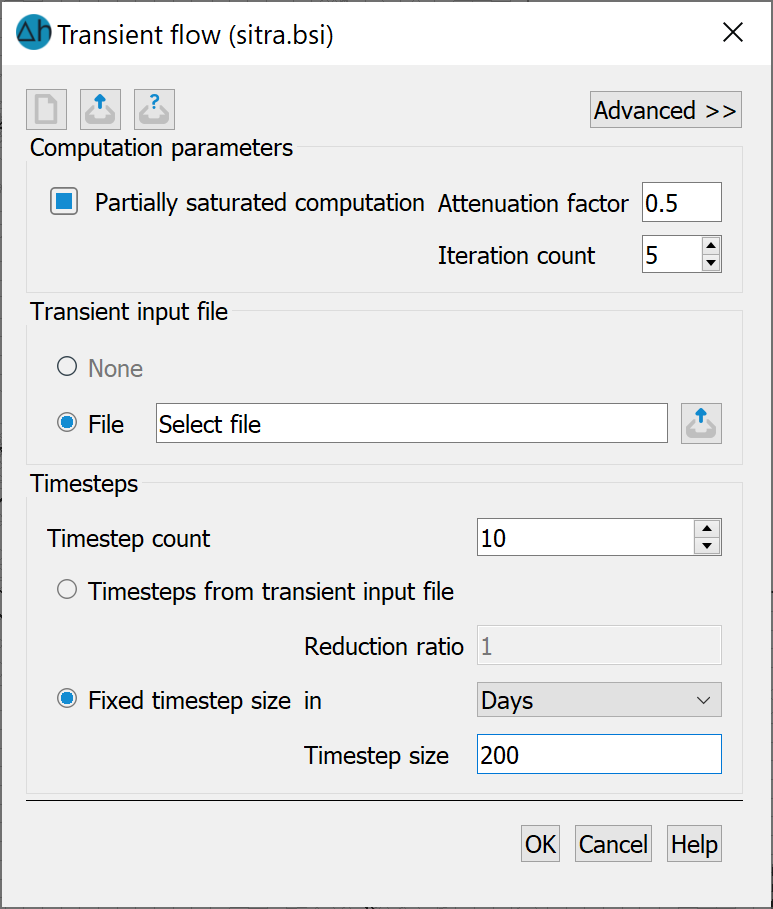The following input window (3D model) appears after selecting in the menu Calculation  Transient flow...:
Transient flow...:

The calculation with the SITRA module is the default preset. Therefore, when the input screen is called up, the batch file with the default name sitra.bsi is read in (if it exists) and the default settings in the screen are changed accordingly if necessary.
You can switch to a calculation with the INSTAT module in the advanced settings. The default name for an INSTAT batch file is instat.bis.
Iteration of thickness (2D model) / partially saturated calculation (3D model)
Firstly, a decision is made as to whether an iteration of the saturated thickness (in the horizontal model) or a partially saturated calculation for the iteration of the free surface (in the 3D model) is to be carried out. If yes, the desired number of iteration steps is defined. In 2D horizontal models, a transient flow calculation with iteration of the saturated thickness is only updated and not iteratively changed. Therefore, the number of iteration steps is automatically set to "1" and the checkbox is deactivated. For an inverse model calculation, the number of iteration steps is generally set to "1".
Attenuation factor
To avoid oscillations during iteration, the change in saturated thickness from one iteration step to the next is given an attenuation/damping factor of 0 < w < 1. For 2D horizontal models, the attenuation factor is set to "1" and the selection field does not appear.
Considering confined/unconfined conditions
This checkbox only appears for a 2D horizontal model with a thickness restricted by the UNDU or OBER attribute. If there are confined conditions, these can be taken into account when calculating the storage coefficient by activating the checkbox. Otherwise, the storage coefficient is determined for unconfined conditions (see chapter: "Calculation of the storage coefficient").
Transient input file
Selection of the file containing the transient data (file selection window).
Time steps
Time step count:
Enter the number of time steps to be calculated.
Influencing the time steps:
When entering the parameters for the transient calculation, the times at which the calculation is to be performed can be influenced in various ways.
Selection 1: Time steps from transient input file
Only the time points from the transient input file are used. A reduction ratio can be specified here.
Selection 2: Fixed time step size
Alternatively, a fixed time step can be entered independently of the transient input file (e.g. every 2 days). If these fixed times coincide with those of the input file, the corresponding boundary conditions are set. Time steps in the transient input file that do not fall within the time step grid are ignored and a warning is issued.
Example:
Time step count: 10
Fixed time step size: n = 200 days
This performs a transient flow calculation over 10 * 200 = 2000 days. At the end of the calculation, results are then available after 200, 400, 600, ... and 2000 days.
The buttons at the top of the input window allow you to reset the input parameters ( ), open an existing batch file (
), open an existing batch file ( ) or save the current batch file under a different name (
) or save the current batch file under a different name ( ). The buttons at the bottom of the input window start the calculation (OK button), closes the windows (Cancel) or opens the digital help (Help button). The "Advanced" selection leads to additional settings.
). The buttons at the bottom of the input window start the calculation (OK button), closes the windows (Cancel) or opens the digital help (Help button). The "Advanced" selection leads to additional settings.
